Switzerland is a beautiful country that is extremely geologically diverse, resulting in diverse climates as well. Comprised of six regions that offer unique climates this also creates terroirs within that specialize in specific cépages (grape varietals) in that you can taste nuances in bouquets of the same wine varietal between different areas. All 26 cantons in Switzerland cultivate wine! Rotating clockwise from the western point of Switzerland, the six regions are: Geneva, Vaud, Three-Lakes, the German region, Ticino, and the Valais. The country produces approximately 48% white wines and 52% red, with nearly 70% of the total production taking place in western Switzerland along Lake Geneva (Lac Léman) and in the south and southeast amidst the Rhône Valley. Learn about each individual region below!
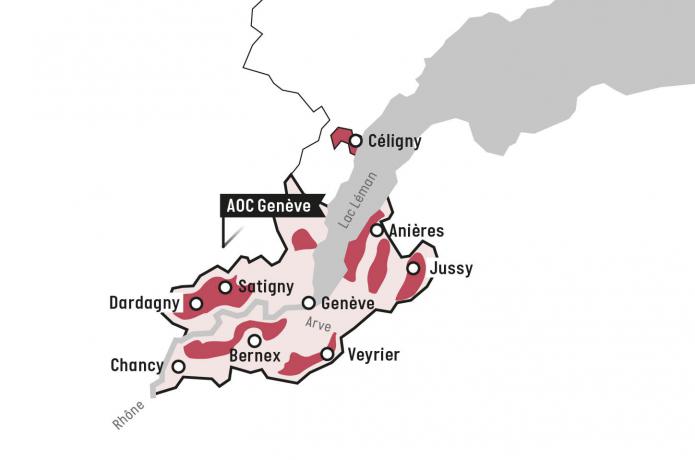
Geneva
Historically the first region to cultivate wine on Swiss soil via the Allobroges territory of the Celtics tribe, dating back to 800BC.
Only 6 miles from the United Nations and World Trade Organization headquarters.
1,410 hectares of vineyards ranks it fourth amongst Swiss regions by size.
Chasselas originated in the Lake Geneva region and now makes up 25% of the total vineyards in Switzerland.
Gamay is the specialty red in this region with Pinot Noir not far behind, other specialties include Chardonnay, Pinot Gris and Aligoté.
Gamaret, Garanoir and Chasselas are indigenous to this region.
The Jura Mountains and nearby Alps deflect bad weather entering the region from the west, along with the slopes along Lake Geneva being less susceptible to spring frost develop this region's unique climate. Deposits left from the two rivers, the Rhône and the Arve, provide a great variety in soil composition throughout the region giving its wine varietals a unique bouquet of flavors.
Geneva produces 57% red varietals and 43% white.
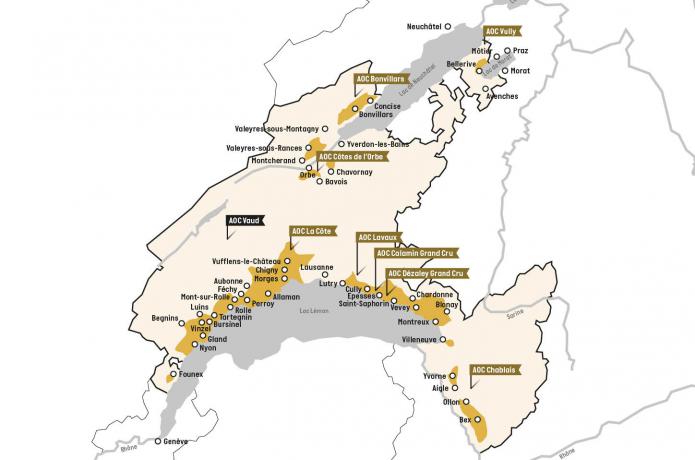
Vaud
Comprised of 8 AOCs in 4 zones (La Côte, Lavaux, Chablais & North Vaud), Vaud has over 1000 years of history and centuries of tradition making it one of the oldest winemaking regions in Switzerland.
Lavaux was deemed a UNESCO World Heritage Site in 2007 in respect to the Dézaley vineyards being dated back to 996AD which were cultivated by Cistercian monks.
3,775 hectares of vineyards ranks it second amongst Swiss regions by size.
Nicknamed "The Temple of Chasselas" for its fruity-fresh white wines of Chasselas. Grown in nearly 2/3 of Vaud's vineyards, decades of maturity has grown recognition for these old vines.
25% of production comes from Gamay and Pinot Noir.
Chasselas, Gamaret and Garanoir are indigenous to this region.
Fêtes des Vignerons is a popular, highly sought after traditional show that is only celebrated once every 25 years. It is the most authentic expression of Vaud's deeply rooted wine history.
Vaud produces 66% white varietals and 34% red.
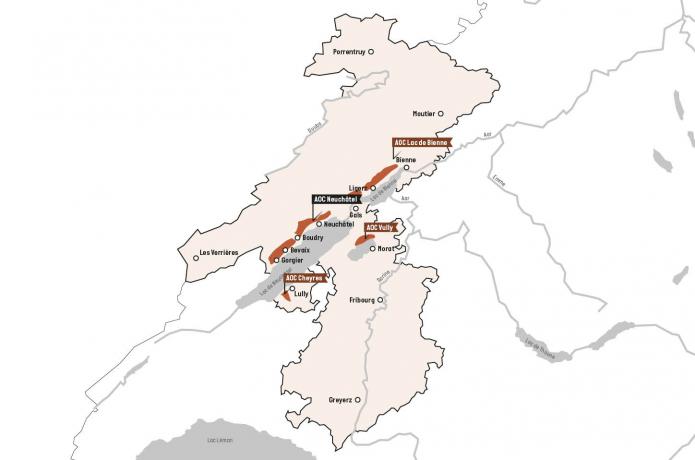
Three-Lakes
The Three-Lakes region extends from the southwest to northeast Jura range and encapsulates Lake Neuchâtel, Lake Biel and Lake Murten. Most of the vineyards can be found along a 20 mile stretch along the southeast facing slopes of the lake.
Neuchâtel is considered the most ecological of all regions in Switzerland, over 20% of vineyards are grown under organic production.
945 hectares of vineyards makes it the smallest Swiss region by size.
Pinot Noir is the main red grape grown and less earthy and fruitier than counterparts in Valais, in fact it is the only red varietal allowed in the cantons (states) of Neuchâtel and Bern.
Very close to Burgundy, Three-Lakes was the first to introduce Pinot to Switzerland alongside Vaud.
Specializes in a magnificently light and crisp Chasselas which is given a diverse bouquet due to the soil diversity, often rich in limestone, from one vineyard to the next.
Gamaret, Garanoir and Chasselas are indigenous to this region.
Three-Lakes produces 56% red varietals and 44% white.
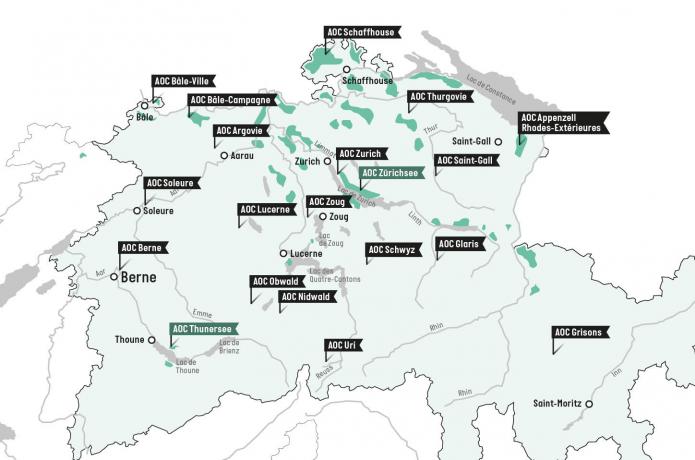
German
Historically the first region to cultivate wine on Swiss soil via the Allobroges territory of the Celtics tribe, dating back to 800BC.
Only 6 miles from the United Nations and World Trade Organization headquarters.
1,410 hectares of vineyards ranks it fourth amongst Swiss regions by size.
Chasselas originated in the Lake Geneva region and now makes up 25% of the total vineyards in Switzerland.
Gamay is the specialty red in this region with Pinot Noir not far behind, other specialties include Chardonnay, Pinot Gris and Aligoté.
Gamaret, Garanoir and Chasselas are indigenous to this region.
The Jura Mountains and nearby Alps deflect bad weather entering the region from the west, along with the slopes along Lake Geneva being less susceptible to spring frost develop this region's unique climate. Deposits left from the two rivers, the Rhône and the Arve, provide a great variety in soil composition throughout the region giving its wine varietals a unique bouquet of flavors.
Geneva produces 57% red varietals and 43% white.
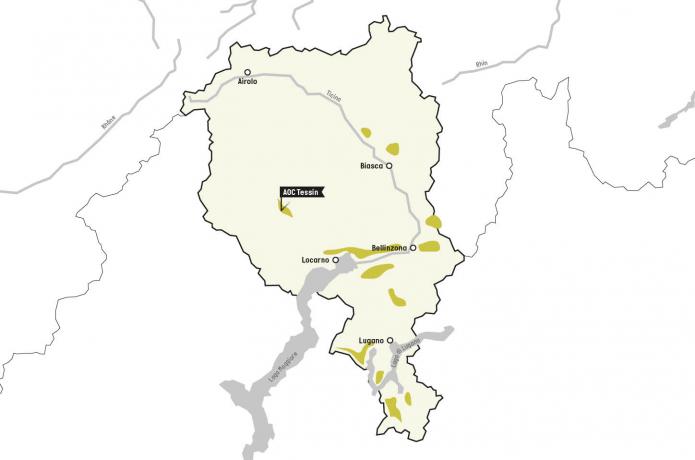
Ticino
The most southern region of Switzerland and the only canton located completely south of the Alps. Monte Ceneri divides Ticino into two zones: the Sopraceneri (Bellinzona) in the north and the Sottoceneri (Lugano) in the south.
Neighboring the Piedmont and Lombardy provinces of Italy, its most important grape varietal is Merlot. The Mediterranean climate provides the ideal environment for Merlot with high rainfall and lots of sunshine.
1,096 hectares of vineyards ranks it fifth amongst Swiss regions by size.
A rapidly growing region, viticulture has grown 20% over the last 20 years.
The lowest vineyard in Switzerland is located in Ticino, the Maggia delta near Ascona is only 200m above sea level.
A typical Ticino wine is Bondola, also known as Nostrano, which comes from Sopraceneri. Some grape varieties are chosen to be kept as eating grapes or used to make its famous Grappa.
Specializing in Merlot and competing with Bordeaux for the crown, about 80% of vineyards are Merlot, which led to a white wine derivative called Merlot Bianco.
Ticino produces 91% red varietals and 9% white.
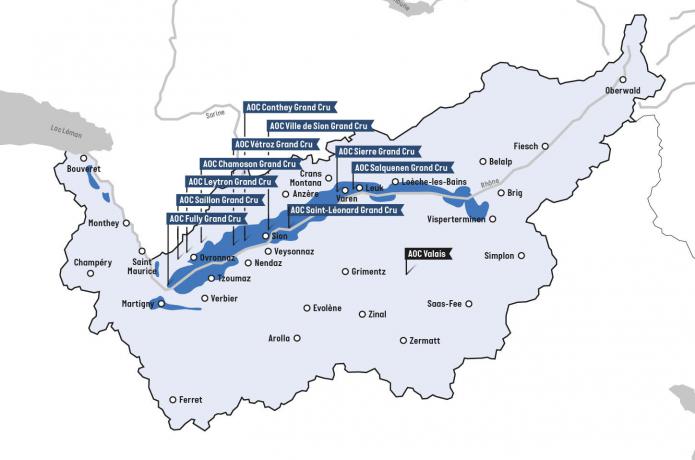
Three-Lakes
Located in the southwestern region of Switzerland, mostly lying in the Alps. Receiving its water source from the Rhône glacier in eastern Valais, most of the region's vineyards can be found along the slopes of the Rhône river banks. over 62 miles long with terraces ranging from 270m to 1100m above sea level.
Referred to as the highest wine regions in Europe, the highest vineyards in Europe are located deep into the side valley in a town called Visperterminen also known as the Heida Village.
4,795 hectares of vineyards ranks it first amongst Swiss regions by size.
The combination of geological upheaves, receding glaciers, and alluvial deposits from the rivers create a strong diversity in soil. Combined with the warm, dry climate it allows the region to grow many international varietals such as Syrah.
Offering one of the largest grape varietals of any region, hidden gems are specialties such as the whites Petite Arvine, Amigne, and Heida, along with the reds Humagne and Cornalin.
31 white varietals and 24 red are authorized in AOC Valais.
Known most for its Fendant (a name specific to the Valais, otherwise known as Chasselas) and Dôle, a traditional blend of Pinot and Gamay.
Gamaret, Diolinoir, Chasselas and Arvine are indigenous to this region.
Valais produces 61% red varietals and 39% white.




